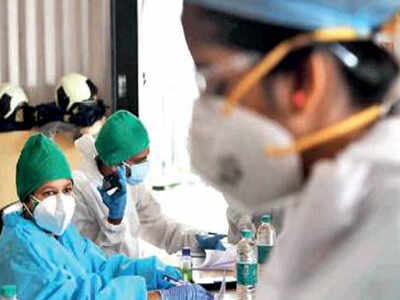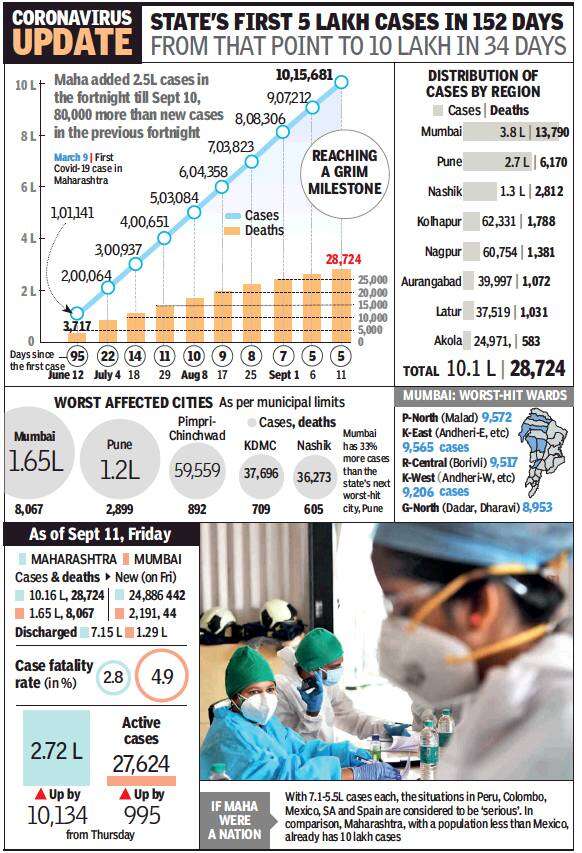
PUNE: On the first Monday of September, Pune became the first district in the country to cross the two lakh-infected mark.
A week later, Pune Metropolitan Region, which has among the highest concentration of urban and semi-urban spaces in the district, registered its single highest 24-hour tally with 4,935 new patients. As on Thursday, it had 40,152 active patients.

Now, the good news. Nearly 80% of the two lakh patients have been discharged.
Seven months into the outbreak in Pune, since the first case on March 9, many have wondered if more could have been done to control the spread and limit the deaths—4,800—in a city that has some of the best scientific institutions in the country.
The first serological survey in the city, results for which were announced in August, had found that 51% of the population across five high-incidence zones had already had the infection —indicating a strong, early wave. Prevalence was high at 62.2% among those with access only to common toilets. It was relatively lower at 45.3% among those with own toilets at home.
“Our findings indicate that there has been an extensive spread of Covid-19 in these parts,” said a researcher with the survey team.
The administration has not been able to get ahead of the virus. Contact tracing, described as the backbone of any disease surveillance programme, remains abysmally low in Pune. The administration has been tracking just 10 contacts per confirmed case—the lowest in the state. Indian Council of Medical Research mandates at least 20.
A week later, Pune Metropolitan Region, which has among the highest concentration of urban and semi-urban spaces in the district, registered its single highest 24-hour tally with 4,935 new patients. As on Thursday, it had 40,152 active patients.

Now, the good news. Nearly 80% of the two lakh patients have been discharged.
Seven months into the outbreak in Pune, since the first case on March 9, many have wondered if more could have been done to control the spread and limit the deaths—4,800—in a city that has some of the best scientific institutions in the country.
The first serological survey in the city, results for which were announced in August, had found that 51% of the population across five high-incidence zones had already had the infection —indicating a strong, early wave. Prevalence was high at 62.2% among those with access only to common toilets. It was relatively lower at 45.3% among those with own toilets at home.
“Our findings indicate that there has been an extensive spread of Covid-19 in these parts,” said a researcher with the survey team.
The administration has not been able to get ahead of the virus. Contact tracing, described as the backbone of any disease surveillance programme, remains abysmally low in Pune. The administration has been tracking just 10 contacts per confirmed case—the lowest in the state. Indian Council of Medical Research mandates at least 20.

Coronavirus outbreak
Trending Topics
LATEST VIDEOS
City
 On cam: Navy veteran brutally beaten up by Shiv Sena goons for satirical WhatsApp forward
On cam: Navy veteran brutally beaten up by Shiv Sena goons for satirical WhatsApp forward  Delhi: International drug racket busted; Kingpin nabbed, Rs 90 crore worth heroin seized
Delhi: International drug racket busted; Kingpin nabbed, Rs 90 crore worth heroin seized  SSR death probe: Drugs were sent through courier from Sushant's house to Rhea's during lockdown
SSR death probe: Drugs were sent through courier from Sushant's house to Rhea's during lockdown  Sushant Singh Rajput is ‘beta’ of Bihar: Devendra Fadnavis
Sushant Singh Rajput is ‘beta’ of Bihar: Devendra Fadnavis
More from TOI
Navbharat Times
Featured Today in Travel
Quick Links
Kerala Coronavirus Helpline NumberHaryana Coronavirus Helpline NumberUP Coronavirus Helpline NumberBareilly NewsBhopal NewsCoronavirus in DelhiCoronavirus in HyderabadCoronavirus in IndiaCoronavirus symptomsCoronavirusRajasthan Coronavirus Helpline NumberAditya ThackerayShiv SenaFire in MumbaiAP Coronavirus Helpline NumberArvind KejriwalJammu Kashmir Coronavirus Helpline NumberSrinagar encounter
Get the app





